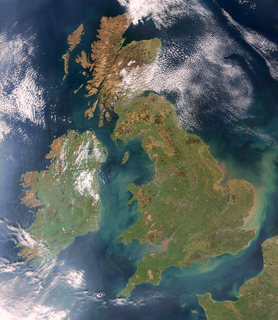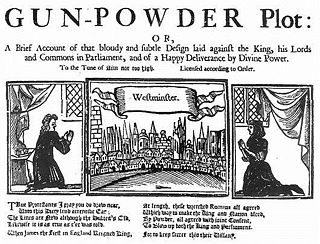
Bede, also known as Saint Bede, Venerable Bede, and Bede the Venerable, was an English Benedictine monk at the monastery of St. Peter and its companion monastery of St. Paul in the Kingdom of Northumbria of the Angles. Born on lands likely belonging to the Monkwearmouth monastery in present-day Sunderland, Bede was sent there at the age of seven and later joined Abbot Ceolfrith at the Jarrow monastery, both of whom survived a plague that struck in 686, an outbreak that killed a majority of the population there. While he spent most of his life in the monastery, Bede travelled to several abbeys and monasteries across the British Isles, even visiting the archbishop of York and King Ceolwulf of Northumbria. He is well known as an author, teacher, and scholar, and his most famous work, Ecclesiastical History of the English People, gained him the title "The Father of English History". His ecumenical writings were extensive and included a number of Biblical commentaries and other theological works of exegetical erudition. Another important area of study for Bede was the academic discipline of computus, otherwise known to his contemporaries as the science of calculating calendar dates. One of the more important dates Bede tried to compute was Easter, an effort that was mired with controversy. He also helped establish the practice of dating forward from the birth of Christ, a practice which eventually became commonplace in medieval Europe. Bede was one of the greatest teachers and writers of the Early Middle Ages and is considered by many historians to be the single most important scholar of antiquity for the period between the death of Pope Gregory I in 604 and the coronation of Charlemagne in 800.

The history of Europe covers the peoples inhabiting Europe from prehistory to the present. During the Neolithic era and the time of the Indo-European migrations Europe saw human inflows from east and southeast and subsequent important cultural and material exchange. The period known as classical antiquity began with the emergence of the city-states of ancient Greece. Later, the Roman Empire came to dominate the Mediterranean Basin and Northwest Europe. The fall of the Roman Empire in AD 476 traditionally marks the start of the Middle Ages. Beginning in the 14th century a Renaissance of knowledge challenged traditional doctrines in science and theology. Simultaneously, the Protestant Reformation set up Protestant churches primarily in Germany, Scandinavia and England. After 1800, the Industrial Revolution brought prosperity to Britain and Western Europe. The main powers set up colonies in most of the Americas and Africa, and parts of Asia. In the 20th century, World War I and World War II resulted in massive numbers of deaths. The Cold War dominated European geo-politics from 1947 to 1989.

In the history of Europe, the Middle Ages lasted from the 5th to the 15th century. It began with the fall of the Western Roman Empire and merged into the Renaissance and the Age of Discovery. The Middle Ages is the middle period of the three traditional divisions of Western history: classical antiquity, the medieval period, and the modern period. The medieval period is itself subdivided into the Early, High, and Late Middle Ages.

The Roman Empire was the post-Roman Republic period of the ancient Roman civilization. Ruled by emperors, it had large territorial holdings around the Mediterranean Sea in Europe, North Africa, the Middle East, and the Caucasus. From the constitutional reforms of Augustus to the military anarchy of the third century, the Empire was a principate ruled from the city of Rome. The Roman Empire was then ruled by multiple emperors and divided in a Western Roman Empire, based in Milan and later Ravenna, and an Eastern Roman Empire, based in Nicomedia and later Constantinople. Rome remained the nominal capital of both parts until 476 AD, when Odoacer deposed Romulus Augustus after capturing Ravenna and the Roman Senate sent the imperial regalia to Constantinople. The fall of the Western Roman Empire to barbarian kings, along with the hellenization of the Eastern Roman Empire into the Byzantine Empire, is conventionally used to mark the end of Ancient Rome and the beginning of the Middle Ages.

Pope Gregory VII, born Hildebrand of Sovana, was pope from 22 April 1073 to his death in 1085.

The Roman triumph was a civil ceremony and religious rite of ancient Rome, held to publicly celebrate and sanctify the success of a military commander who had led Roman forces to victory in the service of the state or, originally and traditionally, one who had successfully completed a foreign war.

The Polish–Lithuanian Commonwealth – formally, the Crown of the Kingdom of Poland and the Grand Duchy of Lithuania and, after 1791, the Commonwealth of Poland – was a dual state, a bi-confederation of Poland and Lithuania ruled by a common monarch, who was both King of Poland and Grand Duke of Lithuania. It was one of the largest and most populous countries of 16th– to 17th-century Europe. At its largest territorial extent, in the early 17th century, the Commonwealth covered almost 400,000 square miles (1,000,000 km2) and sustained a multi-ethnic population of 11 million.

Perotinus Magnus, was a composer from around the late 12th century, associated with the Notre Dame school of polyphony in Paris and the ars antiqua musical style. The title Magister Perotinus, means that he was licensed to teach. The only information on his life with any degree of certainty comes from an anonymous English student at Notre Dame known as Anonymous IV. It is assumed that he was French and named Pérotin, a diminutive of Peter, but attempts to match him with persons in other documents remain speculative.

The Ecclesiastical History of the English People, written by the Venerable Bede in about AD 731, is a history of the Christian Churches in England, and of England generally; its main focus is on the conflict between the pre-Schism Roman Rite and Celtic Christianity. It was originally composed in Latin, and is considered one of the most important original references on Anglo-Saxon history and has played a key role in the development of an English national identity. It is believed to have been completed in 731 when Bede was approximately 59 years old.

The Pontifical University of Saint Thomas Aquinas (PUST), also known as the Angelicum in honor of its patron the Doctor Angelicus Thomas Aquinas, is located in the historic center of Rome, Italy. It is directly dependent on the Pope for its status as a pontifical university as outlined in the apostolic constitution Sapientia Christiana, which also clarifies the parameters of Church authority and academic freedom. The Angelicum is administered by the Catholic Order of Preachers, also known as the Dominican Order, and is a central locus of traditional Dominican Thomist theology and philosophy.

Jehovah is a Latinization of the Hebrew יְהֹוָה, one vocalization of the Tetragrammaton יהוה (YHWH), the proper name of the God of Israel in the Hebrew Bible and one of the seven names of God in Judaism.
Máel Coluim was a tenth-century King of Strathclyde. He was a younger son of Dyfnwal ab Owain, King of Strathclyde, and thus a member of the Cumbrian dynasty that had ruled the kingdom for generations. Máel Coluim's Gaelic name could indicate that he was born during either an era of amiable relations with the Scots, or else during a period of Scottish overlordship. In 945, the Edmund I, King of the English invaded the kingdom, and appears to have granted the Scots permission to dominate the Cumbrians. The English king is further reported to have blinded several of Máel Coluim's brothers in an act that could have been an attempt to deprive Dyfnwal of an heir.
Óláfr Guðrøðarson was a twelfth-century King of the Isles. As a younger son of Guðrøðr Crovan, King of Dublin and the Isles, Óláfr witnessed a vicious power struggle between his elder brothers in the aftermath of their father's death. At some point, the young Óláfr was entrusted to the care of Henry I, King of England, and like the contemporaneous Scottish monarchs, Alexander I and David I, Óláfr appears to have been a protégé of the English king. As King of the Isles, Óláfr contracted marital alliances with neighbouring maritime rulers. Although he appears to have overseen successful military operations to reclaim the northern-most territories once controlled by his father, he may have witnessed the loss of authority in Galloway as well. Like his counterpart David I, Óláfr was a reformer and moderniser of his realm. However, his four-decade reign ended in abrupt disaster when he was assassinated by three nephews in 1153. Following the ensuing power struggle, Óláfr's son Guðrøðr overcame the kin-slayers, and assumed the kingship of the Kingdom of the Isles.

In British English usage, the toponym "British Isles" refers to a European archipelago consisting of Great Britain, Ireland and adjacent islands. However, the word "British" is also an adjective and demonym referring to the United Kingdom and more historically associated with the British Empire. For this reason, the name British Isles is avoided by some in Hiberno-English, as such usage could be construed to imply continued territorial claims or political overlordship of the Republic of Ireland by the United Kingdom.
Ruaidhrí mac Raghnaill was a leading figure in the Kingdom of the Isles and a member of Clann Somhairle. He was a son of Raghnall mac Somhairle, and was the eponymous ancestor of Clann Ruaidhrí. Ruaidhrí may have become the principal member of Clann Somhairle following the annihilation of Aonghus mac Somhairle in 1210. At about this time, Ruaidhrí seems to have overseen a marital alliance with the reigning representative of the Crovan dynasty, Rǫgnvaldr Guðrøðarson, King of the Isles, and to have contributed to a reunification of the Kingdom of the Isles between Clann Somhairle and the Crovan dynasty.

The Order of Saint Augustine, generally called Augustinians or Austin Friars, is a Catholic religious order. It was founded in 1254 by bringing together several eremetical orders in the Tuscany region who were following the Rule of St. Augustine, written by St. Augustine of Hippo in the 5th Century.

In ancient Roman religion and myth, Mars was the god of war and also an agricultural guardian, a combination characteristic of early Rome. He was second in importance only to Jupiter and he was the most prominent of the military gods in the religion of the Roman army. Most of his festivals were held in March, the month named for him, and in October, which began the season for military campaigning and ended the season for farming.

This article presents a list of notable historical references to the name Palestine as a place name in the Middle East throughout the history of the region, including its cognates such as "Filastin" and "Palaestina".


















